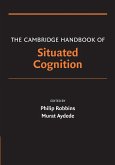The Cambridge Handbook of Group Interaction Analysis
Herausgeber: Brauner, Elisabeth; Kolbe, Michaela; Boos, Margarete
The Cambridge Handbook of Group Interaction Analysis
Herausgeber: Brauner, Elisabeth; Kolbe, Michaela; Boos, Margarete
- Broschiertes Buch
- Merkliste
- Auf die Merkliste
- Bewerten Bewerten
- Teilen
- Produkt teilen
- Produkterinnerung
- Produkterinnerung
A compendium of research methods on behavioral coding of verbal and nonverbal interaction, indispensable for studying interaction and communication.
Andere Kunden interessierten sich auch für
![The Cambridge Handbook of Group Interaction Analysis The Cambridge Handbook of Group Interaction Analysis]() The Cambridge Handbook of Group Interaction Analysis183,99 €
The Cambridge Handbook of Group Interaction Analysis183,99 €![The Cambridge Handbook of Identity The Cambridge Handbook of Identity]() The Cambridge Handbook of Identity198,99 €
The Cambridge Handbook of Identity198,99 €![The Cambridge Handbook of Political Psychology The Cambridge Handbook of Political Psychology]() The Cambridge Handbook of Political Psychology197,99 €
The Cambridge Handbook of Political Psychology197,99 €![The Cambridge Handbook of the Psychology of Prejudice The Cambridge Handbook of the Psychology of Prejudice]() The Cambridge Handbook of the Psychology of Prejudice191,99 €
The Cambridge Handbook of the Psychology of Prejudice191,99 €![The Cambridge Handbook of Implicit Bias and Racism The Cambridge Handbook of Implicit Bias and Racism]() The Cambridge Handbook of Implicit Bias and Racism201,99 €
The Cambridge Handbook of Implicit Bias and Racism201,99 €![The Cambridge Handbook of the Learning Sciences The Cambridge Handbook of the Learning Sciences]() The Cambridge Handbook of the Learning Sciences186,99 €
The Cambridge Handbook of the Learning Sciences186,99 €![The Cambridge Handbook of Situated Cognition The Cambridge Handbook of Situated Cognition]() The Cambridge Handbook of Situated Cognition79,99 €
The Cambridge Handbook of Situated Cognition79,99 €-
-
-
A compendium of research methods on behavioral coding of verbal and nonverbal interaction, indispensable for studying interaction and communication.
Hinweis: Dieser Artikel kann nur an eine deutsche Lieferadresse ausgeliefert werden.
Hinweis: Dieser Artikel kann nur an eine deutsche Lieferadresse ausgeliefert werden.
Produktdetails
- Produktdetails
- Verlag: Cambridge University Press
- Seitenzahl: 696
- Erscheinungstermin: 6. März 2019
- Englisch
- Abmessung: 246mm x 189mm x 38mm
- Gewicht: 1322g
- ISBN-13: 9781107533875
- ISBN-10: 1107533872
- Artikelnr.: 51152961
- Herstellerkennzeichnung
- Books on Demand GmbH
- In de Tarpen 42
- 22848 Norderstedt
- info@bod.de
- 040 53433511
- Verlag: Cambridge University Press
- Seitenzahl: 696
- Erscheinungstermin: 6. März 2019
- Englisch
- Abmessung: 246mm x 189mm x 38mm
- Gewicht: 1322g
- ISBN-13: 9781107533875
- ISBN-10: 1107533872
- Artikelnr.: 51152961
- Herstellerkennzeichnung
- Books on Demand GmbH
- In de Tarpen 42
- 22848 Norderstedt
- info@bod.de
- 040 53433511
Part I. Background and Theory: 1. Interaction analysis: an introduction; 2.
History of group interaction research; Part II. Application Areas of
Interaction Analysis: 3. Dyadic interaction analysis; 4. Observing group
interaction: the benefits of taking group dynamics seriously; 5. Unpacking
the structures of team interaction patterns; 6. Coding nonverbal behavior;
7. Behavioral coding in animals; 8. Beyond coding interaction: new horizons
in interaction analysis; Part III. Methodology and Procedures of
Interaction Analysis: 9. Coding interaction: a technical introduction; 10.
Rules for coding scheme development; 11. Unitizing verbal interaction data
for coding: rules and reliability; 12. Quality control: assessing
reliability and validity; 13. Software for coding and analyzing interaction
processes; Part IV. Data Analysis and Data Presentation: 14. Coding and
counting - frequency analysis for group interaction research; 15. Analysis
of interaction sequences; 16. Temporal patterns in interactions: T-patterns
and their detection with THEMEtm; 17. Interdependence in small group
discussion; 18. Coding and analyzing multiple levels; 19. Introduction to
machine learning: teaching computers to code group interaction data; 20.
Tint - a technique for visualizing team processes; Part V. Coding Schemes
for Interaction Research: General Group Process Systems: 21. The advanced
interaction analysis for teams (act4teams) coding scheme; 22. Discussion
Coding System (DCS); 23. Interaction Process Analysis (IPA); 24. TEMPO: a
time-based system for analysis of group interaction process; Section 1.
Argument, Conflict, and Negotiations: 25. Argument - a category system for
analyzing argumentation in group discussions; 26. Group working
relationships coding system; 27. Micro-conflict coding scheme; 28. Offer:
behaviorally coding indirect and direct information exchange in
negotiations; 29. Verbal tactics coding scheme (Vtcs); Section 2.
Coordination and Coherence: 30. Coco - a category system for coding
coherence in conversations; 31. Co-act - a framework for observing
coordination behavior in acute care teams; 32. So-Dic-Or: simultaneous
observation of distractions and communication in the operating room;
Section 3. Cognition and Meta-Cognition: 33. Casorl - coding scheme for the
analysis of socially regulated learning; 34. Coding scheme for group
creativity; 35. Analyzing critical thinking in group constellations: from
discourse analysis to analyzing social modes of thinking; 36. Identifying
teacher and student contributions during assessment conversations: the
elevate coding scheme; 37. In search of synergy in group decisions: coding
hidden profile discussions; 38. Trawis - coding transactive knowledge and
knowledge exchange; Section 4. Personality and Team Behavior: 39. The
behavior analysis coding system - an applied, real-time approach for
measuring and improving interactive skills; 40. Groupness/entitativity
observational coding (Geoc): a coding system to assess groupness or
entitativity in groups; 41. Assessing group interactions in personality
psychology: the Münster behavior coding-system (M-BeCoSy); Section 5. Roles
and Relationships: 42. BRRICS: brief romantic relationship interaction
coding scheme; 43. (Family) relational communication control coding system;
44. Verbal response modes taxonomy.
History of group interaction research; Part II. Application Areas of
Interaction Analysis: 3. Dyadic interaction analysis; 4. Observing group
interaction: the benefits of taking group dynamics seriously; 5. Unpacking
the structures of team interaction patterns; 6. Coding nonverbal behavior;
7. Behavioral coding in animals; 8. Beyond coding interaction: new horizons
in interaction analysis; Part III. Methodology and Procedures of
Interaction Analysis: 9. Coding interaction: a technical introduction; 10.
Rules for coding scheme development; 11. Unitizing verbal interaction data
for coding: rules and reliability; 12. Quality control: assessing
reliability and validity; 13. Software for coding and analyzing interaction
processes; Part IV. Data Analysis and Data Presentation: 14. Coding and
counting - frequency analysis for group interaction research; 15. Analysis
of interaction sequences; 16. Temporal patterns in interactions: T-patterns
and their detection with THEMEtm; 17. Interdependence in small group
discussion; 18. Coding and analyzing multiple levels; 19. Introduction to
machine learning: teaching computers to code group interaction data; 20.
Tint - a technique for visualizing team processes; Part V. Coding Schemes
for Interaction Research: General Group Process Systems: 21. The advanced
interaction analysis for teams (act4teams) coding scheme; 22. Discussion
Coding System (DCS); 23. Interaction Process Analysis (IPA); 24. TEMPO: a
time-based system for analysis of group interaction process; Section 1.
Argument, Conflict, and Negotiations: 25. Argument - a category system for
analyzing argumentation in group discussions; 26. Group working
relationships coding system; 27. Micro-conflict coding scheme; 28. Offer:
behaviorally coding indirect and direct information exchange in
negotiations; 29. Verbal tactics coding scheme (Vtcs); Section 2.
Coordination and Coherence: 30. Coco - a category system for coding
coherence in conversations; 31. Co-act - a framework for observing
coordination behavior in acute care teams; 32. So-Dic-Or: simultaneous
observation of distractions and communication in the operating room;
Section 3. Cognition and Meta-Cognition: 33. Casorl - coding scheme for the
analysis of socially regulated learning; 34. Coding scheme for group
creativity; 35. Analyzing critical thinking in group constellations: from
discourse analysis to analyzing social modes of thinking; 36. Identifying
teacher and student contributions during assessment conversations: the
elevate coding scheme; 37. In search of synergy in group decisions: coding
hidden profile discussions; 38. Trawis - coding transactive knowledge and
knowledge exchange; Section 4. Personality and Team Behavior: 39. The
behavior analysis coding system - an applied, real-time approach for
measuring and improving interactive skills; 40. Groupness/entitativity
observational coding (Geoc): a coding system to assess groupness or
entitativity in groups; 41. Assessing group interactions in personality
psychology: the Münster behavior coding-system (M-BeCoSy); Section 5. Roles
and Relationships: 42. BRRICS: brief romantic relationship interaction
coding scheme; 43. (Family) relational communication control coding system;
44. Verbal response modes taxonomy.
Part I. Background and Theory: 1. Interaction analysis: an introduction; 2.
History of group interaction research; Part II. Application Areas of
Interaction Analysis: 3. Dyadic interaction analysis; 4. Observing group
interaction: the benefits of taking group dynamics seriously; 5. Unpacking
the structures of team interaction patterns; 6. Coding nonverbal behavior;
7. Behavioral coding in animals; 8. Beyond coding interaction: new horizons
in interaction analysis; Part III. Methodology and Procedures of
Interaction Analysis: 9. Coding interaction: a technical introduction; 10.
Rules for coding scheme development; 11. Unitizing verbal interaction data
for coding: rules and reliability; 12. Quality control: assessing
reliability and validity; 13. Software for coding and analyzing interaction
processes; Part IV. Data Analysis and Data Presentation: 14. Coding and
counting - frequency analysis for group interaction research; 15. Analysis
of interaction sequences; 16. Temporal patterns in interactions: T-patterns
and their detection with THEMEtm; 17. Interdependence in small group
discussion; 18. Coding and analyzing multiple levels; 19. Introduction to
machine learning: teaching computers to code group interaction data; 20.
Tint - a technique for visualizing team processes; Part V. Coding Schemes
for Interaction Research: General Group Process Systems: 21. The advanced
interaction analysis for teams (act4teams) coding scheme; 22. Discussion
Coding System (DCS); 23. Interaction Process Analysis (IPA); 24. TEMPO: a
time-based system for analysis of group interaction process; Section 1.
Argument, Conflict, and Negotiations: 25. Argument - a category system for
analyzing argumentation in group discussions; 26. Group working
relationships coding system; 27. Micro-conflict coding scheme; 28. Offer:
behaviorally coding indirect and direct information exchange in
negotiations; 29. Verbal tactics coding scheme (Vtcs); Section 2.
Coordination and Coherence: 30. Coco - a category system for coding
coherence in conversations; 31. Co-act - a framework for observing
coordination behavior in acute care teams; 32. So-Dic-Or: simultaneous
observation of distractions and communication in the operating room;
Section 3. Cognition and Meta-Cognition: 33. Casorl - coding scheme for the
analysis of socially regulated learning; 34. Coding scheme for group
creativity; 35. Analyzing critical thinking in group constellations: from
discourse analysis to analyzing social modes of thinking; 36. Identifying
teacher and student contributions during assessment conversations: the
elevate coding scheme; 37. In search of synergy in group decisions: coding
hidden profile discussions; 38. Trawis - coding transactive knowledge and
knowledge exchange; Section 4. Personality and Team Behavior: 39. The
behavior analysis coding system - an applied, real-time approach for
measuring and improving interactive skills; 40. Groupness/entitativity
observational coding (Geoc): a coding system to assess groupness or
entitativity in groups; 41. Assessing group interactions in personality
psychology: the Münster behavior coding-system (M-BeCoSy); Section 5. Roles
and Relationships: 42. BRRICS: brief romantic relationship interaction
coding scheme; 43. (Family) relational communication control coding system;
44. Verbal response modes taxonomy.
History of group interaction research; Part II. Application Areas of
Interaction Analysis: 3. Dyadic interaction analysis; 4. Observing group
interaction: the benefits of taking group dynamics seriously; 5. Unpacking
the structures of team interaction patterns; 6. Coding nonverbal behavior;
7. Behavioral coding in animals; 8. Beyond coding interaction: new horizons
in interaction analysis; Part III. Methodology and Procedures of
Interaction Analysis: 9. Coding interaction: a technical introduction; 10.
Rules for coding scheme development; 11. Unitizing verbal interaction data
for coding: rules and reliability; 12. Quality control: assessing
reliability and validity; 13. Software for coding and analyzing interaction
processes; Part IV. Data Analysis and Data Presentation: 14. Coding and
counting - frequency analysis for group interaction research; 15. Analysis
of interaction sequences; 16. Temporal patterns in interactions: T-patterns
and their detection with THEMEtm; 17. Interdependence in small group
discussion; 18. Coding and analyzing multiple levels; 19. Introduction to
machine learning: teaching computers to code group interaction data; 20.
Tint - a technique for visualizing team processes; Part V. Coding Schemes
for Interaction Research: General Group Process Systems: 21. The advanced
interaction analysis for teams (act4teams) coding scheme; 22. Discussion
Coding System (DCS); 23. Interaction Process Analysis (IPA); 24. TEMPO: a
time-based system for analysis of group interaction process; Section 1.
Argument, Conflict, and Negotiations: 25. Argument - a category system for
analyzing argumentation in group discussions; 26. Group working
relationships coding system; 27. Micro-conflict coding scheme; 28. Offer:
behaviorally coding indirect and direct information exchange in
negotiations; 29. Verbal tactics coding scheme (Vtcs); Section 2.
Coordination and Coherence: 30. Coco - a category system for coding
coherence in conversations; 31. Co-act - a framework for observing
coordination behavior in acute care teams; 32. So-Dic-Or: simultaneous
observation of distractions and communication in the operating room;
Section 3. Cognition and Meta-Cognition: 33. Casorl - coding scheme for the
analysis of socially regulated learning; 34. Coding scheme for group
creativity; 35. Analyzing critical thinking in group constellations: from
discourse analysis to analyzing social modes of thinking; 36. Identifying
teacher and student contributions during assessment conversations: the
elevate coding scheme; 37. In search of synergy in group decisions: coding
hidden profile discussions; 38. Trawis - coding transactive knowledge and
knowledge exchange; Section 4. Personality and Team Behavior: 39. The
behavior analysis coding system - an applied, real-time approach for
measuring and improving interactive skills; 40. Groupness/entitativity
observational coding (Geoc): a coding system to assess groupness or
entitativity in groups; 41. Assessing group interactions in personality
psychology: the Münster behavior coding-system (M-BeCoSy); Section 5. Roles
and Relationships: 42. BRRICS: brief romantic relationship interaction
coding scheme; 43. (Family) relational communication control coding system;
44. Verbal response modes taxonomy.








